A Private Tour for the day down to the Broads today. It was a glorious day to be out – the wind was light and after high cloud in the morning, we were treated to a wonderfully clear, sunny winter’s afternoon.
Our first target was Cranes. We set off along the coast road, checking out various of their regular spots. At first, all seemed quiet, but little did we know what was around the next corner. Scanning the sky, two large birds appeared way off in the distance but heading straight towards us, a pair of Cranes. We pulled off into a convenient layby and watched them as they flew in, turning north across in front of us before circling low over the trees.
 Cranes – we watched our first of the morning fly in
Cranes – we watched our first of the morning fly in
They were clearly trying to land, but took a couple of attempts to do so, circling up again in between. Eventually the two Cranes dropped down out of view behind the trees. A great start to the morning. Over the other side of the road, small groups of Pink-footed Geese were flying in and landing on the meadows. Ahead of us on the wires, a Fieldfare perched precariously.
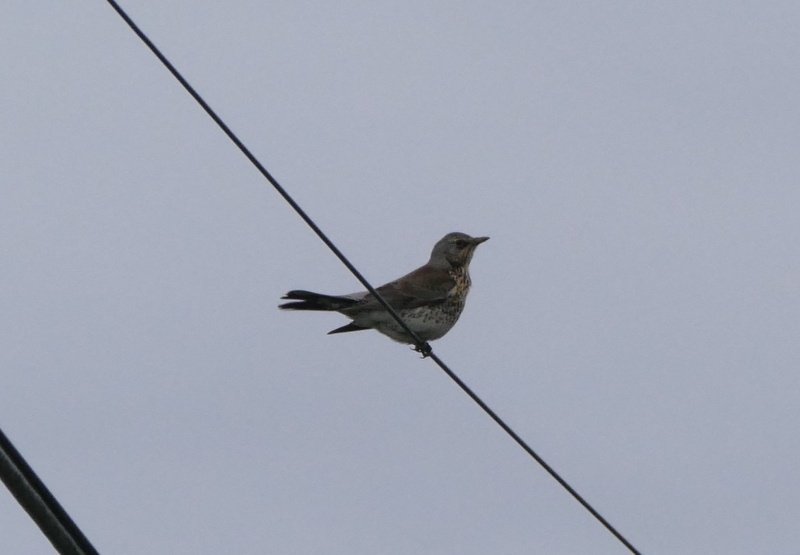 Fieldfare – perched on the wires above the road
Fieldfare – perched on the wires above the road
We drove on a little further and pulled in again off the road. A couple of Marsh Harriers were circling over the reedbed behind and a Barn Owl was perched on a distant fence post. The grazing meadows looked rather quiet at first, apart from a liberal scattering of Lapwings, but a careful scan revealed more Cranes. This time, a pair were standing out on the grass, busy preening. We got them in the scope this time and had a really good look at them – noting the red crown patch particularly on the larger of the two birds, the male.
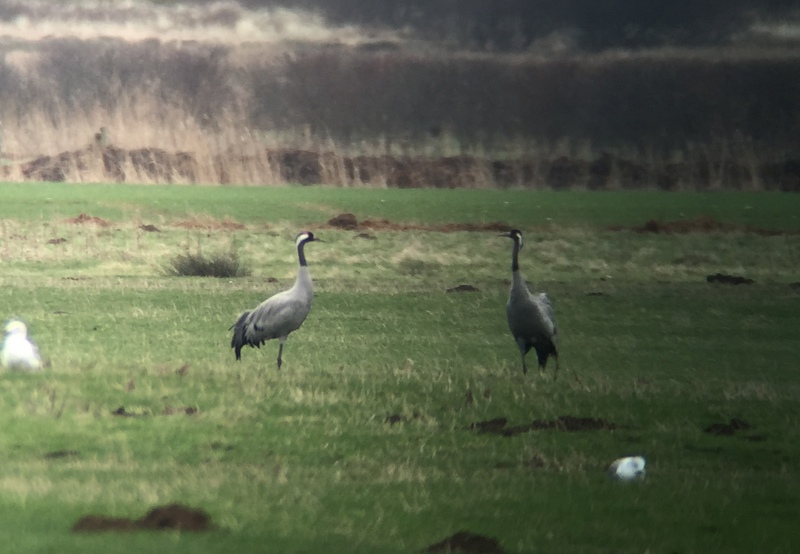 Cranes – our second pair of the day, preening in a field
Cranes – our second pair of the day, preening in a field
A helicopter flew overhead and the Cranes seemed to take little notice as it did so. It did spook all the Pink-footed Geese which then took flight from the fields beyond. The Cranes seemed to be more concerned with the actions of the geese, and now raised their heads and looked round to see what was happening.
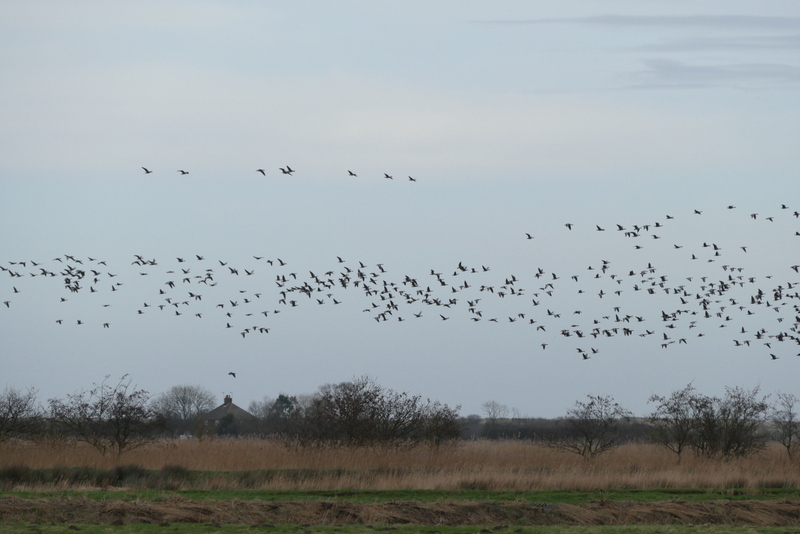 Pink-footed Geese – spooked by a passing helicopter
Pink-footed Geese – spooked by a passing helicopter
Out at the back of the meadows, we picked up a ringtail Hen Harrier out hunting. It was flying round and repeatedly dropping down onto the ground. We managed to get it in the scope, before it flew off strongly and over behind a hedge, pursued by a couple of Crows.
While we were watching the Hen Harrier, another pair of Cranes appeared over the meadows flying straight towards us. We had to check at first, but the other pair were still standing on the grass. They flew steadily in our direction, across the road a short distance back the way we had just come, and dropped down out of view behind the trees. An amazing start to the day – three pairs of Cranes in such a small area.
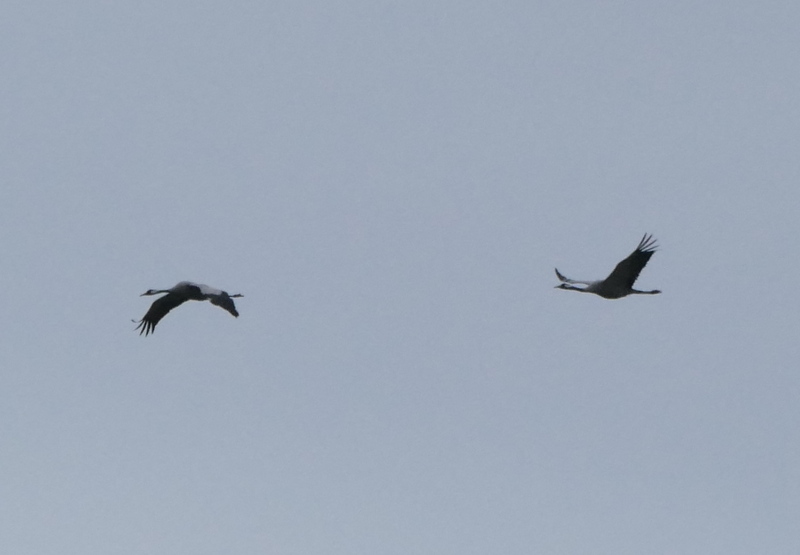 Cranes – our third pair of the morning, flew across the road
Cranes – our third pair of the morning, flew across the road
By this time, we figured that we deserved a coffee break, so we drove back to where we could park. We were within earshot of where we had seen the two pairs of Cranes land earlier and we could hear them bugling to each other – quite a way to spend your morning break, listening to the sound of calling Cranes!
After such a successful start to the morning, and being so spoilt with Cranes (or so we thought!), we decided to head off and do something different. We made our way along to Winterton and parked by the beach. Snow Bunting had been mentioned as a bird on the wish list to see, so a walk along the beach here made sense. It was nice to get out for a bracing stroll along the sand.
There were lots of dog walkers out on the beach and we had to get past them before we found the Snow Buntings. Eleven flew down the beach towards us and landed on the shingle behind us, where we had just walked. We made our way back and got the scope on them, but just as the dogs caught us up and they flew again. Thankfully the Snow Buntings landed up on the ridge further out on the beach and watched from there as the dogs passed. Once the danger was gone, we got much better views as they picked about for seeds on the stones.
 Snow Bunting – looking for seeds out on the beach
Snow Bunting – looking for seeds out on the beach
Several of the Snow Buntings settled down for a rest, tucking themselves down in little depressions in the shingle so that only their heads were showing. At this point they were remarkably well camouflaged, shades of brown, russet, grey and off white matching the colours of the stones. It was only because we knew where they were that we could see them.
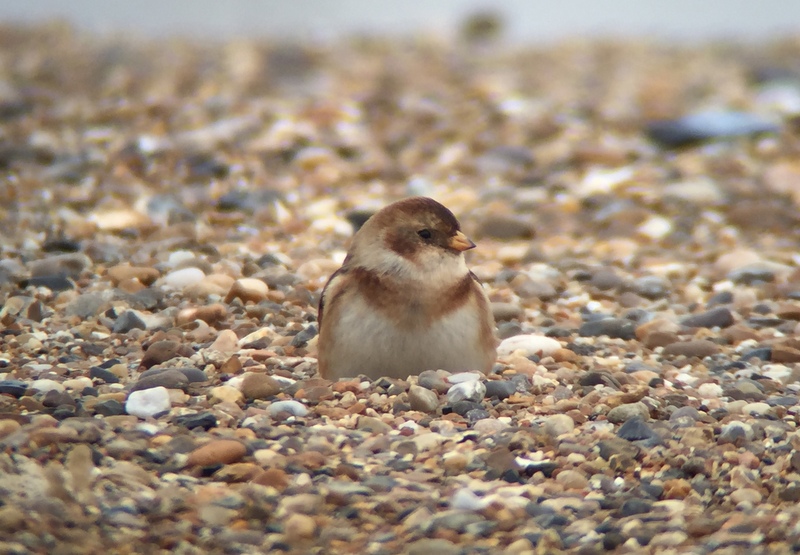 Snow Bunting – very well camouflaged among the stones
Snow Bunting – very well camouflaged among the stones
A couple of Skylarks were picking about on the beach as well, among the sandier places on the edge of the dunes. Two Sanderlings appeared on the ridge and a Ringed Plover flew along ahead of us. There were lots of Cormorants flying past offshore, presumably commuting between their fishing grounds and the favoured roosting place on Scroby Sands further south. A distant Gannet flew past casually, overtaken by the Cormorants. A Red-throated Diver in winter plumage was on the sea just offshore, drifting with the tide.
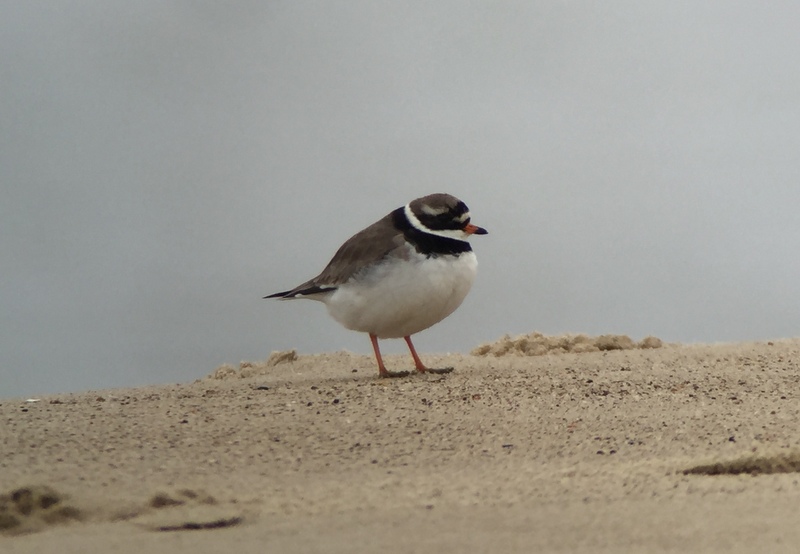 Ringed Plover – on the beach at Winterton
Ringed Plover – on the beach at Winterton
We meandered our way inland through Crane country from here. Scanning some favoured meadows revealed another three Cranes, but they were rather distant. It was a challenge to pick them out, as they were working their way through a deep bed of rushes. The road was busy and there was nowhere convenient to stop. Having done so well for Cranes already this morning, we had a quick look through binoculars from the car and moved on.
Little did we realise what might be around the next corner. It is always worth keeping your eyes peeled on the fields around here and a shout from the eagle-eyed spotter on the passenger side went up as we almost drove past another pair of Cranes. They were tucked down in the corner of a field right next to the road, behind a hedge! A quick u-turn in a convenient gateway and we drove back slowly past on the other side of the road. We carried on a little further past them, where we thought we wouldn’t disturb them and stayed in the car.
 Crane – we surprised a pair in a field right next to the road
Crane – we surprised a pair in a field right next to the road
The two Cranes were clearly a little nervous and walked slowly out into the middle of the field, treating us to fantastic close-up views as they did so. Unfortunately, there was a lot of traffic on the road and a large lorry went past at that moment which spooked them. They took off – necks down, walking at first, then running with huge wings beating to get them airborne – and dropped down again a little further over. Wow! What a treat to see Cranes like that. And that took us to a total of 11 for the day!
We made our way over to Strumpshaw Fen for lunch. We had a couple of different options for the early afternoon, but the choice was made to walk out onto the reserve here. There were lots of ducks on the area of open water in front of Reception Hide – Gadwall, Teal, Mallard and Shoveler. And a good number of Coots. A Marsh Harrier circled over the trees out in the middle of the reedbed.
 Shoveler – catching the winter sun at Strumpshaw Fen
Shoveler – catching the winter sun at Strumpshaw Fen
As we walked through the trees, we could hear a Song Thrush singing ahead of us. Such a beautiful song and so sad that it is a species in decline, but we are still blessed with a number here. A little party of Siskins were feeding in the alders above our heads, hanging upside down to pick at the cones for the seeds.
 Siskin – feeding in the alders above the path
Siskin – feeding in the alders above the path
As we walked out along Sandy Wall, we could hear a Marsh Tit calling and just caught a couple of glimpses of it as it disappeared away through the trees. It was really beautiful in the crisp afternoon sun, with the light catching the reeds as they rustled in the light winds. We sat in Fen Hide for a short while, but it was rather quiet here again today, so we didn’t linger too long. We didn’t have time to explore the whole of the reserve, so we made our way slowly back. The Song Thrush was still singing from the trees and this time the Marsh Tits gave themselves up properly – a pair picking about in the oak trees above the path.
Our next appointment was with the swans, so we made our way back north through the Broads to Ludham. Thankfully, they are still in their usual fields at the moment. Most of the Whooper Swans were in a separate group, picking at the remains of the sugar beet tops in the field which was harvested some time ago and very close to the road. There are still around 40 here at the moment. A tractor was in the process of ploughing the field, pursued by a throng of Black-headed Gulls, so the Whooper Swans were probably making the most of the sugar beet remains while they still can. We had a good look at them from the car as we drove past towards our usual parking spot.
 Whooper Swans – feeding on the remains of the sugar beet tops
Whooper Swans – feeding on the remains of the sugar beet tops
The Bewick’s Swans were out in the winter wheat next door, and a lot of them asleep again this afternoon. Six of them were very close, so we pulled up and got out very slowly and quietly, giving them a chance to walk away slowly to a safe distance, back towards the main herd. They settled down again and we got a really good look at them through the scope.
 Bewick’s Swan – two white adults and a greyer juvenile
Bewick’s Swan – two white adults and a greyer juvenile
There were two Whooper Swans feeding in with the Bewick’s Swans, which gave us a great opportunity to compare the two species side by side. The Whooper Swans were noticeably bigger and with more yellow on the longer bill, extending further down in a wedge shape.
Our final stop of the day was at Hickling Broad. We parked in the car park and set off towards Stubb Mill for the harrier roost. A Barn Owl was hunting around the meadow behind the visitor centre, perching on the fence posts in the late afternoon sunshine.
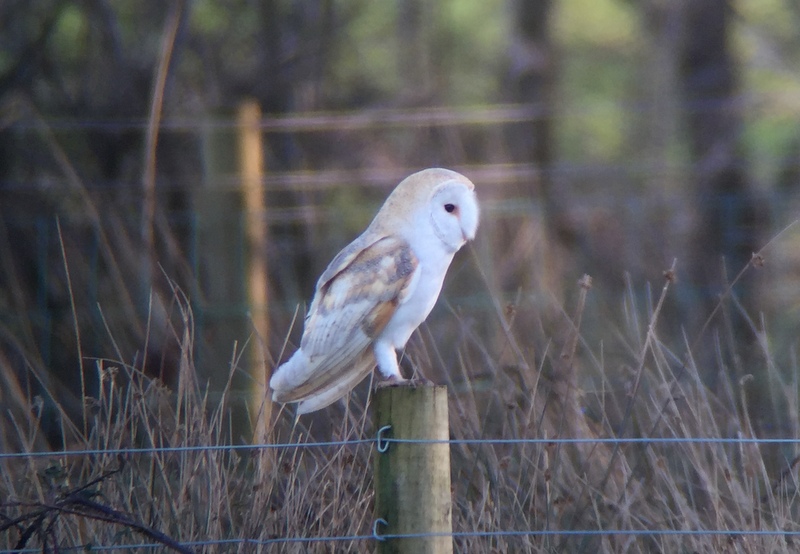 Barn Owl – hunting around the meadows at Hickling Broad
Barn Owl – hunting around the meadows at Hickling Broad
A large flock of Fieldfares were feeding further along the path ahead of us. Some of them were looking particularly bright yellow-orange breasted as they caught the light. Something spooked them and they all flew up into the trees, ‘tchacking’ as they went. As we turned the corner at Stubb Mill, another Barn Owl flew across right in front of us and disappeared out towards the grazing meadows.
There were only about 5-6 Marsh Harriers around the trees when we arrived, but a steady trickle continued to arrive while we were there. There were probably close to 20 by the time we left, with more still arriving, but numbers have started to drop now as the birds start to head off back to their breeding territories. A ringtail Hen Harrier came through low over the meadows in front of us, flashing the white square at the base of its tail as it did so.
A Short-eared Owl flew in from the back and landed on a woodpile in the low sunshine. It perched there preening for the rest of the time we were there – it had obviously enjoyed a successful afternoon’s hunting already. A second Short-eared Owl circled up very distantly over the back of the trees. There were more Barn Owls too – it was hard to know how many we saw altogether here this evening. One was hunting along the field edge behind us and another far off over the reeds in front.
A Chinese Water Deer appeared out in the grass and we got it in the scope. Then it ran across in front of us, before dropping down into one of the ditches, flashing its tusks as it went past. A couple of Red Deer were grazing further over again, and at one point we could see them in the same view as the Short-eared Owl!
A Wildlife Trust van had driven across the marshes as we walked out and there were several people walking around behind Stubb Mill by the time we got there. The two resident Cranes had flown off before we arrived – presumably flushed by all the people and activity. We weren’t too concerned today, as we had enjoyed so many and such good views of Cranes this morning. However, we could hear a number of Cranes bugling from away behind the wood while we stood scanning the marshes – there is a lot of vocal activity from all the Cranes now. It was a lovely evocative way to end the day, listening to Cranes calling as we admired the traditional Broadland landscape.
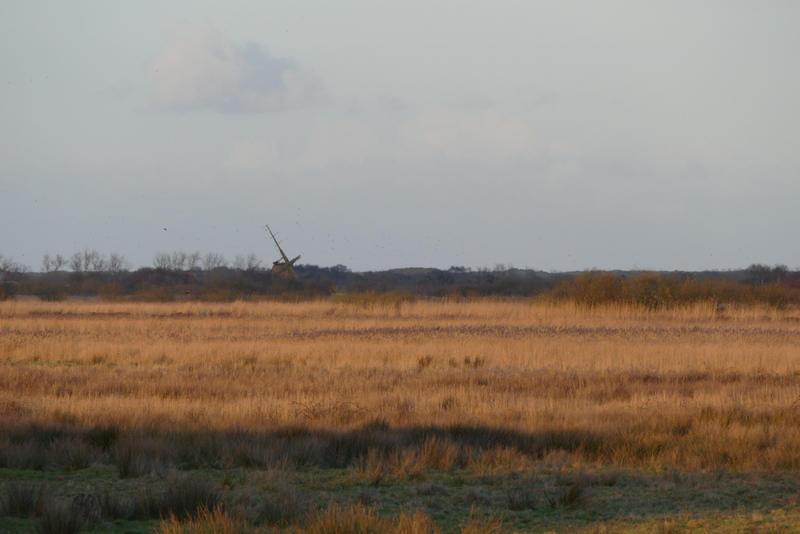 The view from Stubb Mill in the afternoon sun
The view from Stubb Mill in the afternoon sun
















